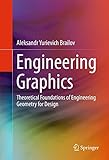Engineering Graphics [electronic resource] : Theoretical Foundations of Engineering Geometry for Design / by Aleksandr Yurievich Brailov.
By: Brailov, Aleksandr Yurievich [author.] .
.
Contributor(s): SpringerLink (Online service) .
.
Material type:  BookPublisher: Cham : Springer International Publishing : Imprint: Springer, 2016Edition: 1st ed. 2016.Description: XIX, 338 p. 251 illus., 105 illus. in color. online resource.Content type: text Media type: computer Carrier type: online resourceISBN: 9783319297194.Subject(s): Engineering mathematics
BookPublisher: Cham : Springer International Publishing : Imprint: Springer, 2016Edition: 1st ed. 2016.Description: XIX, 338 p. 251 illus., 105 illus. in color. online resource.Content type: text Media type: computer Carrier type: online resourceISBN: 9783319297194.Subject(s): Engineering mathematicsDescriptive Geometry -- Types of Projection. The Center of Projection -- Formation of the Complex Drawing. Octants. The method of Gaspard Monge -- Geometrical Models and an Analytical Model of a Point -- Geometric and Analytical Models of a Straight Line -- Geometric Models and Analytical Models of a Plane -- Geometric and Analytical Models of a Surface -- Positional Problems -- Metric Problems -- Development of Surfaces -- Axonometric Projections -- Conclusions -- Appendix.
This professional treatise on engineering graphics emphasizes engineering geometry as the theoretical foundation for communication of design ideas with real world structures and products. It considers each theoretical notion of engineering geometry as a complex solution of direct- and inverse-problems of descriptive geometry and each solution of basic engineering problems presented is accompanied by construction of biunique two- and three-dimension models of geometrical images. The book explains the universal structure of formal algorithms of the solutions of positional, metric, and axonometric problems, as well as the solutions of problems of construction in developing a curvilinear surface. The book further characterizes and explains the added laws of projective connections to facilitate construction of geometrical images in any of eight octants. Laws of projective connections allow constructing the complex drawing of a geometrical image in the American system of measurement and the European system of measurement without errors and mistakes. The arrangement of projections of a geometrical image on the complex drawing corresponds to an arrangement of views of a product in the projective drawing for the European system of measurement. The volume is ideal for engineers working on a range of design projects as well as for students of civil, structural, and industrial engineering and engineering design. • Facilitates development of spatial imagination and imaginative perception in the context of developing a generalized approach to solving geometrical engineering problems; • Explains geometric and analytical models of points, straight lines, planes, and surfaces; • Provides solutions for basic engineering problems accompanied by construction of biunique two- and three-dimension models of geometrical images; • Includes detail on geometric projections and complex drawings; • Provides an arrangement of views of a product in the projective drawing for various systems of measurement. .


There are no comments for this item.